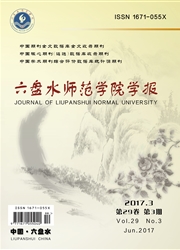

 中文摘要:
中文摘要:
基于可持续发展理念的核心,以贵州省统计资料为依据,计算2005-2013年人均生态足迹和生态承载力,分析生态承载力的动态变化趋势及其对可持续发展研究的影响.结果显示:2005-2013年,贵州省人均生态足迹从3.0545hm2/人上升到4.6395hm2/人.从生态足迹的分组来看,原煤的生态足迹最大,耕地、林地、草地的变化不大,总体呈现递增的趋势,建筑用地和水域都在逐渐增加;人均生态承载力从1.1514 hm2/人上升到1.2491 hm2/人,人均生态足迹增速大于人均生态承载力;导致研究区生态赤字一直不断增加,形势严峻;万元生态足迹从5.8840hm2/万元GDP直线下降到的2.0293 hm2/万元GDP,表明近年来贵州省的资源利用率明显得到提高.
 英文摘要:
英文摘要:
Based on the core of the concept of sustainable development and the statistical data in Guizhou, the writer calculates the per capita ecological footprint and ecological carrying capacity, analyzes the dynamic transfer tendency of ecological capacity and its influence on sustainable development from 2003 to 2015. The re- sults showed that: from 2005 to 2013, the per capita ecological footprint in Guizhou ranges from 3.0545 hm2 to 4.6395 hm2. From the perspective of the group of ecological footprint, the ecological footprint of raw coal is the largest; the changes of cultivated land, forest land, grassland are small, showing a gradually increasing tendency; Building lands and waters are gradually increasing. Per capita ecological carrying capacity ranges from 1.1514 hm2 to 1.2491 hm2 gradually. The ecological deficit in the study area has been increasing and the situations are serious. Within researching years, ten thousand yuan ecological footprint declined from 5.8840 hectares per ten thousand yuan to 2.0293 hectares per ten thousand yuan GDP from 2005 to 2013, which indicates that the avail- ability of resources of Guizhou has been obviously improving.
 同期刊论文项目
同期刊论文项目
 同项目期刊论文
同项目期刊论文
 期刊信息
期刊信息
